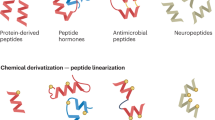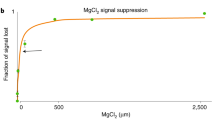Abstract
We report a method for high-throughput, cost-efficient empirical discovery of optimal proteotypic peptides and fragment ions for targeted proteomics applications using in vitro–synthesized proteins. We demonstrate the approach using human transcription factors, which are typically difficult, low-abundance targets and empirically derived proteotypic peptides for 98% of the target proteins. We show that targeted proteomic assays developed using our approach facilitate robust in vivo quantification of human transcription factors.
This is a preview of subscription content, access via your institution
Access options
Subscribe to this journal
Receive 12 print issues and online access
$259.00 per year
only $21.58 per issue
Buy this article
- Purchase on Springer Link
- Instant access to full article PDF
Prices may be subject to local taxes which are calculated during checkout


Similar content being viewed by others
References
Lange, V., Picotti, P., Domon, B. & Aebersold, R. Mol. Syst. Biol. 4, 222 (2008).
Carr, S.A. & Anderson, L. Clin. Chem. 54, 1749–1752 (2008).
Picotti, P. et al. Nat. Methods 5, 913–914 (2008).
Prakash, A. et al. J. Proteome Res. 8, 2733–2739 (2009).
Mallick, P. et al. Nat. Biotechnol. 25, 125–131 (2007).
Fusaro, V.A., Mani, D.R., Mesirov, J.P. & Carr, S.A. Nat. Biotechnol. 27, 190–198 (2009).
Picotti, P. et al. Nat. Methods 7, 43–46 (2010).
Keshishian, H., Addona, T., Burgess, M., Kuhn, E. & Carr, S.A. Mol. Cell. Proteomics 6, 2212–2229 (2007).
Goshima, N. et al. Nat. Methods 5, 1011–1017 (2008).
Ramachandran, N. et al. Nat. Methods 5, 535–538 (2008).
Vaquerizas, J.M., Kummerfeld, S.K., Teichmann, S.A. & Luscombe, N.M. Nat. Rev. Genet. 10, 252–263 (2009).
Rolfs, A. et al. Proc. Natl. Acad. Sci. USA 105, 4364–4369 (2008).
MacLean, B. et al. Bioinformatics 26, 966–968 (2010).
Lee, M.E., Temizer, D.H., Clifford, J.A. & Quertermous, T. J. Biol. Chem. 266, 16188–16192 (1991).
Klenova, E.M. et al. Mol. Cell. Biol. 13, 7612–7624 (1993).
Dorschner, M.O. et al. Nat. Methods 1, 219–225 (2004).
Maclean, B. et al. Anal. Chem. 82, 10116–10124 (2010).
Eng, J.K., McCormack, A.L. & Yates, J.R. J. Am. Soc. Mass Spectrom. 5, 976–989 (1994).
Kall, L., Canterbury, J.D., Weston, J., Noble, W.S. & MacCoss, M.J. Nat. Methods 4, 923–925 (2007).
Frewen, B.E., Merrihew, G.E., Wu, C.C., Noble, W.S. & MacCoss, M.J. Anal. Chem. 78, 5678–5684 (2006).
Acknowledgements
We thank P. von Haller, M. Bereman, E. Hommema and J. Rogers for their discussions and technical assistance. This work was supported in part by the University of Washington's Proteomics Resource (UWPR95794), the Thermo Scientific Pierce Human In vitro Translation Research Grant, and US National Institutes of Health grants P41RR011823 (M.J.M.) and U54HG004592 (J.A.S.).
Author information
Authors and Affiliations
Contributions
A.B.S., J.A.S. and M.J.M. conceived and designed the experiments, and wrote the paper. A.B.S. and K.L. performed the wet laboratory experiments. A.B.S. and B.M. analyzed the data.
Corresponding authors
Ethics declarations
Competing interests
The authors received financial support from ThermoFisher Scientific.
Supplementary information
Supplementary Text and Figures
Supplementary Figures 1–7, Supplementary Data 1–2, Supplementary Note 1 (PDF 4072 kb)
Rights and permissions
About this article
Cite this article
Stergachis, A., MacLean, B., Lee, K. et al. Rapid empirical discovery of optimal peptides for targeted proteomics. Nat Methods 8, 1041–1043 (2011). https://doi.org/10.1038/nmeth.1770
Received:
Accepted:
Published:
Issue Date:
DOI: https://doi.org/10.1038/nmeth.1770
This article is cited by
-
A large-scale targeted proteomics assay resource based on an in vitro human proteome
Nature Methods (2017)
-
PECAN: library-free peptide detection for data-independent acquisition tandem mass spectrometry data
Nature Methods (2017)
-
Metabolic engineering of Clostridium cellulolyticum for the production of n-butanol from crystalline cellulose
Microbial Cell Factories (2016)
-
Food allergen detection by mass spectrometry: the role of systems biology
npj Systems Biology and Applications (2016)
-
Building high-quality assay libraries for targeted analysis of SWATH MS data
Nature Protocols (2015)



